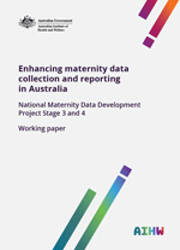Summary
The National Maternity Data Development Project (NMDDP) was established in response to recommendations of the National Maternity Services Plan (NMSP) around improved maternity data collection and reporting.
The primary aim of the NMDDP is the development of nationally consistent maternal and perinatal data collection. This report outlines the progress, led by the AIHW that was made during stages 3 and 4 of the data development project.
Stage 1 of the NMDDP conducted between May 2011 and June 2013 consisted of identifying and prioritising data gaps and inconsistencies in the existing National Perinatal Data Collection (NPDC) and developing a plan to deal with these; developing a nomenclature for defining models of maternity care and the Maternity Care Classification System (MaCCS); achieving progress towards national agreement on standardised reporting of maternal mortality; progressing the national maternal mortality report for 2006–10 and piloting a data linkage study to achieve better ascertainment of maternal deaths; and progressing the standardised national data collection and reporting for perinatal deaths.
The second stage focussed on continuing the development of priority data items and of the MaCCS, extending maternal mortality reporting work, developing methods to better capture and report on national perinatal mortality, and providing greater access to maternal and perinatal data through web tools. Stage 2 was conducted between July 2013 and June 2015.
Stages 3 and 4 conducted from July 2015 to June 2017 included the following achievements:
- the development of nationally consistent maternal and perinatal mortality data collection in Australia with standardised data specifications, annual reporting and data base development
- further progress on developing the data items and type of data to be collected for the psychosocial maternal risk factors (alcohol use during pregnancy, mental health, domestic violence and illicit drug use) that are important contributors to outcomes for mothers and babies
- pilot testing and then the release of an updated data portal module for the maternity models of care (MaCCS) data collection
- an update to the Maternity Information Matrix (MIM) to include the most recent information on data collections and data items relevant to perinatal and maternal health.
Preliminaries: Acknowledgments; Abbreviations
1. Introduction
1.1 The National Perinatal Data Collection
1.2 National Maternity Data Development Project
1.3 Project governance and consultation
2. Maternal and perinatal mortality data collections and reporting
2.1 Background
2.2 Project progress
2.3 Planned future steps
2.4 Conclusion
3. Psychosocial data development
3.1 Alcohol use during pregnancy
3.2 Screening for mental health
3.3 Screening for Domestic Violence
3.4 Illicit substance use during pregnancy
4. Improvements to maternity data
4.1 Maternity Care Classification System data collection
4.2 Maternity Information Matrix
End matter: References; List of tables; List of figures; Related publications



